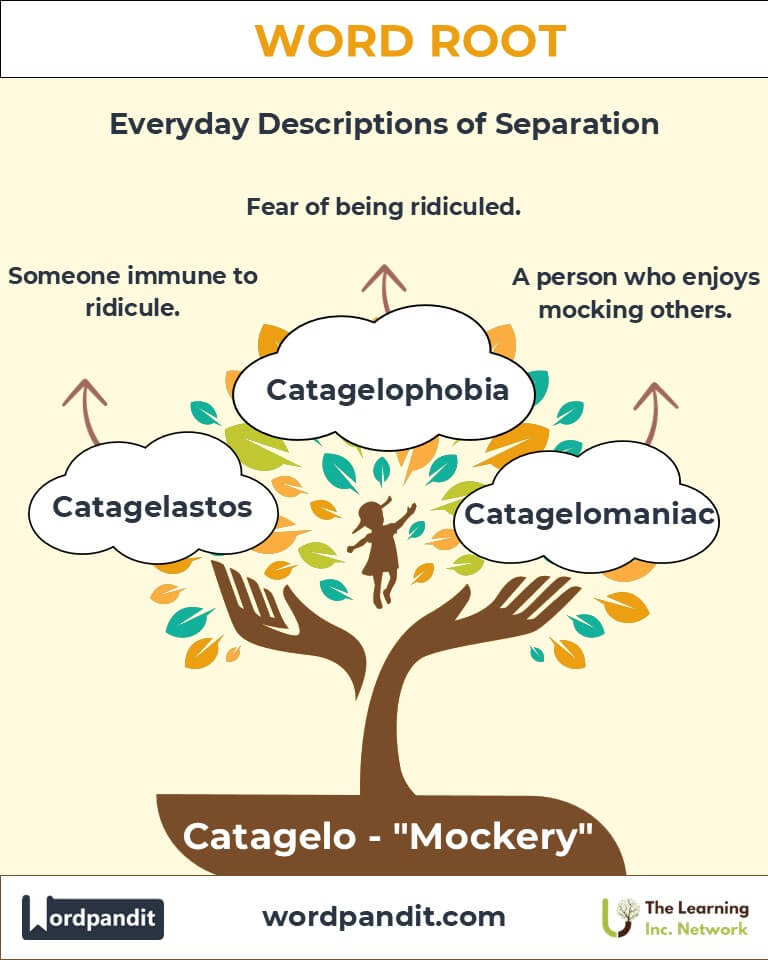Catagelo: The Power of Mockery in Language and Culture
Discover the rich implications of the root "catagelo," originating from Greek, meaning "mockery." Explore how it shapes words, emotions, and societal interactions, highlighting its profound influence on language and culture.

Table of Contents
- Introduction: The Essence of Catagelo
- Etymology and Historical Journey
- Mnemonic: Unlocking the Power of Catagelo
- Common Catagelo-Related Terms
- Catagelo Through Time
- Catagelo in Specialized Fields
- Illustrative Story: Catagelo in Action
- Cultural Significance of the Catagelo Root
- The Catagelo Family Tree
- FAQs about the Catagelo Word Root
- Test Your Knowledge: Catagelo Mastery Quiz
- Conclusion: The Living Legacy of Catagelo
1. Introduction: The Essence of Catagelo
Imagine the biting sting of ridicule or the uneasy laughter sparked by mockery. These emotions tie back to the root "catagelo," derived from the Greek word katagelos, meaning "mockery" or "derision." Pronounced kat-a-geh-loh, this root conveys both humor and harm, forming the basis of words and concepts that delve into human social interactions.

2. Etymology and Historical Journey
The word root "catagelo" stems from the Greek "καταγελω" (katagelo), which combines "kata-" (down, against) and "gelos" (laughter). Ancient Greek philosophers often debated the ethics of mockery, recognizing its power to critique societal norms while cautioning against its potential for harm. Over time, the root traveled through Latin into modern languages, where it shaped terms related to ridicule and the fear of being mocked.
3. Mnemonic: Unlocking the Power of Catagelo
Picture a mischievous jester, laughing mockingly while pointing a finger at someone. This vivid image links "catagelo" to the idea of mockery and ridicule.
Mnemonic Device: “Catagelo brings the laughter down, where humor and harm collide.”
4. Common Catagelo-Related Terms
- Catagelophobia (kat-a-geh-loh-foh-bee-uh): The fear of being ridiculed.
Example: "Her catagelophobia made her avoid public speaking." - Catagelon (kat-a-geh-lon): An act of mockery or ridicule.
Example: "The comedian’s catagelon offended some audience members." - Catagelomaniac (kat-a-geh-loh-may-nee-ak): A person who derives pleasure from mocking others.
Example: "The catagelomaniac thrived on humiliating others during debates." - Katagelastos (kat-a-gel-as-tos): Someone immune to ridicule, often due to indifference or resilience.
Example: "He remained katagelastos despite the crowd’s jeers."
5. Catagelo Through Time
Katagelos (Ancient Greece): Mockery used in satirical plays to critique political figures.
Catagelophobia (Modern): The clinical recognition of fear linked to ridicule, reflecting a deeper understanding of psychological trauma.
6. Catagelo in Specialized Fields
- Psychology:
Catagelophobia is a focus in cognitive-behavioral therapy for those who fear ridicule. - Literature:
Writers use catagelon to highlight societal flaws through satirical narratives. - Sociology:
Analyzing the role of ridicule in maintaining or challenging social hierarchies.
7. Illustrative Story: Catagelo in Action
Lila, a shy student, dreaded her school’s talent show because of her catagelophobia. Her fear of mockery paralyzed her as she prepared to perform. However, with the encouragement of a resilient friend, she overcame her anxiety and discovered that the audience’s laughter was not ridicule but genuine joy. This moment transformed her perspective on fear and self-expression.
8. Cultural Significance of the Catagelo Root
Throughout history, mockery has been a double-edged sword—used to expose truths in comedy but also to ostracize and belittle. From Greek satire to modern memes, catagelo remains a powerful tool in shaping public opinion and cultural norms.

9. The Catagelo Family Tree
- Gel- (laughter):
- Gelastic: Pertaining to laughter or humor.
- Gelosophy: The study of laughter and its effects.
- Satir- (mock):
- Satirical: Critiquing through humor or ridicule.
- Satirist: A writer or performer specializing in satire.
10.FAQs About the Karpo Word Root
Q: What does "karpo" mean?
A: "Karpo" is a Greek root meaning "fruit." It symbolizes both physical fruits and the concept of productivity and fruition, forming the basis for many botanical and scientific terms.
Q: What is karpology?
A: Karpology is the scientific study of fruits, examining their structures, development, and classification. It provides insights into plant reproduction and seed dispersal mechanisms.
Q: How does "karpogamy" differ from "pollination"?
A: Pollination refers to the transfer of pollen between male and female reproductive parts of a plant. Karpogamy, on the other hand, involves the fusion of fruit structures during development, occurring after fertilization.
Q: What is a carpophore?
A: A carpophore is a stalk-like structure that supports the fruiting body in fungi or parts of a compound fruit. For instance, in parsley fruits, the carpophore splits to support each half of the fruit.
Q: What is the difference between "endocarp" and "exocarp"?
A: The endocarp is the innermost layer of a fruit, often hard and protective, like the pit of a peach. The exocarp, in contrast, is the outermost layer, such as the skin or rind of a fruit.
11.Test Your Knowledge: Karpo Word Root Quiz
1. What does "karpo" mean?
2. What is karpology?
3. What does karpogamy involve?
4. Which term describes the innermost layer of a fruit?
5. Which field focuses on plant reproductive structures?

12. Conclusion: The Living Legacy of Catagelo
The root "catagelo" reveals the dual nature of mockery as both a source of humor and harm. Its impact spans fields from psychology to culture, reflecting humanity’s complex relationship with ridicule. Understanding this root empowers us to recognize and navigate the fine line between humor and hurt.











